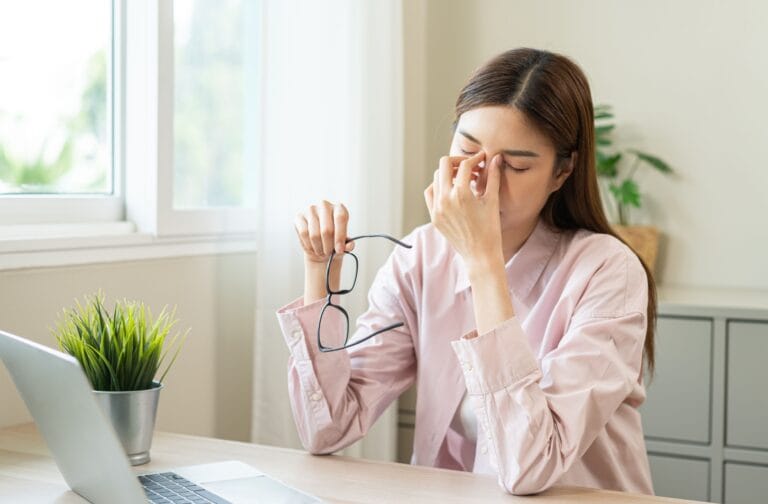Dry, irritated eyes can feel like more than just a minor inconvenience—often, they can disrupt your entire day. From reading to working at a computer, even the simplest tasks become frustrating when your eyes aren’t comfortable. But can dry eyes actually cause headaches? Dry eyes don’t cause headaches or migraines, but there may be a connection between the two. Let’s explore how dry eye disease develops, its relationship to headaches, and what treatment options can help you find relief.
What Is Dry Eye Disease?
Your eyes depend on a protective tear film to stay comfortable, lubricated, and healthy. This tear film acts like a shield, protecting your eyes against irritants and keeping your vision clear. To function properly, it needs a delicate balance of three layers:
- Mucus – helps the tears stick to the surface of the eye
- Water – hydrates the eyes and flushes away debris
- Oils – provide a smooth surface and prevent tears from evaporating too quickly
When this balance breaks down, the result is dry eye disease. This is a common condition, and it’s often chronic.
There are two main types of dry eye disease:
- Aqueous-deficient dry eye – when your eyes don’t produce enough tears.
- Evaporative dry eye – when tears evaporate too quickly, often due to issues with the tiny oil glands in the eyelids.
Both types can leave your eyes feeling gritty, sore, and fatigued.
Dry Eye Symptoms & Their Link to Headaches
Dry eye disease shows up in a variety of ways, and sometimes its symptoms overlap with other conditions. Common symptoms include:
- Burning, stinging, or scratchy sensations in the eyes
- Red, irritated eyes
- Blurred vision or sensitivity to light
- A gritty feeling, like something is stuck in your eye
- Difficulty wearing contact lenses
These symptoms can be linked to the way your eyes respond when they’re not properly hydrated or lubricated. Without enough moisture, the visual system may become more easily fatigued, and that tiredness can contribute to tension felt around the temples and forehead.
What Causes Dry Eyes?
Dry eye disease can develop for several reasons, and often multiple factors work together. Some of the most common include:
- Aging – natural tear production decreases over time
- Environmental factors – dry air, wind, or prolonged screen use
- Medical conditions – autoimmune conditions like Sjögren’s syndrome
- Medications – certain antidepressants, antihistamines, and birth control
- Contact lenses – reduced oxygen flow to the eyes
- Hormonal changes – pregnancy, menopause, or hormone therapy
Pinpointing the root cause is essential for choosing the right treatment.
Finding Relief for Dry Eyes
The good news is that dry eye disease is treatable. Depending on the severity and underlying cause, both at-home changes and in-office treatments may be helpful.
Simple at-home strategies include:
- Using a humidifier to add moisture to dry indoor air
- Wearing sunglasses outdoors to protect from wind and UV light
- Applying warm compresses to unclog eyelid oil glands
- Using artificial tears for extra hydration
If these steps aren’t enough, we may suggest in-office options like intense pulsed light (IPL) therapy or Low Level Light Therapy (LLLT) treatments.
- IPL therapy applies gentle pulses of light around the eyelids, helping oil glands function properly again.
- LLLT uses a noninvasive approach to stimulate tissue repair, reduce inflammation, and enhance the production of healthy tears.
Both are safe, effective, and non-invasive, with many patients experiencing noticeable relief after just a few sessions.
Avulux: Relief for Migraine-Related Headaches
If you experience frequent headaches or migraines, Avulux lenses may help. Avulux is a type of precision-tinted lens designed to filter out specific light wavelengths that can trigger or worsen migraines, while still allowing in the soothing natural light your eyes need.
These lenses are particularly helpful if you struggle with light sensitivity (photophobia)—a common symptom in both dry eye sufferers and migraine patients. Wearing Avulux can make a big difference in reducing discomfort during daily activities, especially when combined with dry eye treatment.

Take Control of Your Comfort
Dry eyes don’t just make your eyes feel uncomfortable—they can also add to overall strain that some people notice alongside headaches or migraines. Getting the right care can ease symptoms and support better eye comfort. While the relationship between dry eyes and headaches isn’t fully understood, they can sometimes show up together, making it worth discussing both with your eye doctor.
If you’re struggling with dry eyes in Brooklin, ON, ERC Optometry is here to help. Our team can assess your tear film, recommend the right treatment—including advanced options like IPL, LLLT, and Avulux lenses—and create a personalized plan for lasting relief. Request an appointment today and take the first step toward clearer, more comfortable vision.

